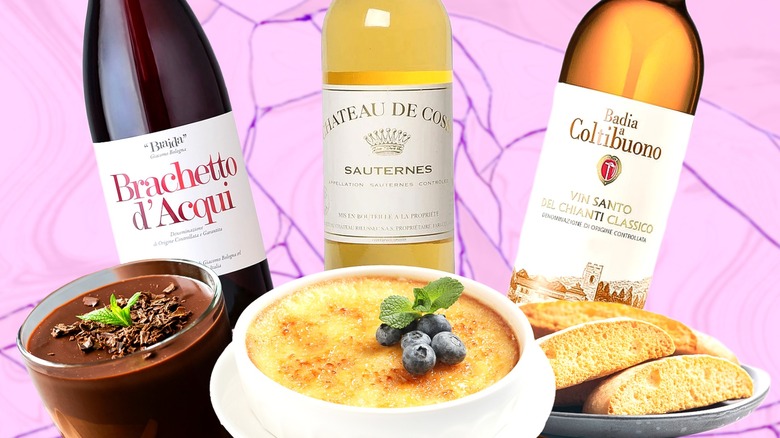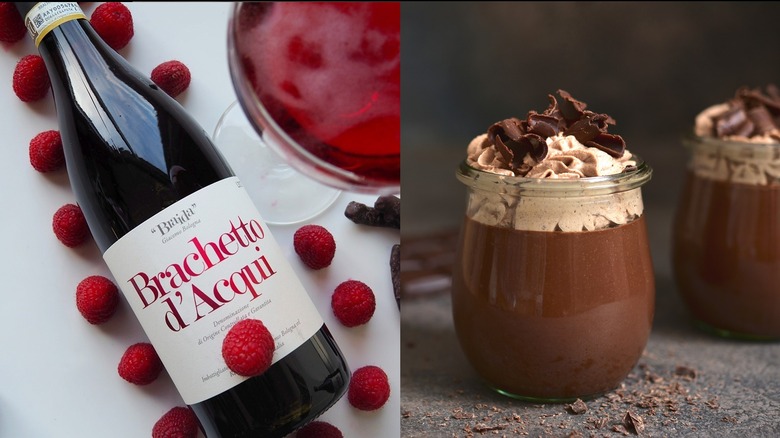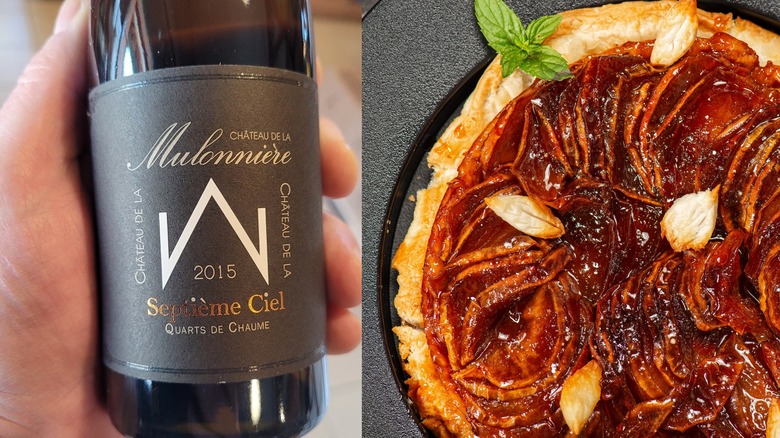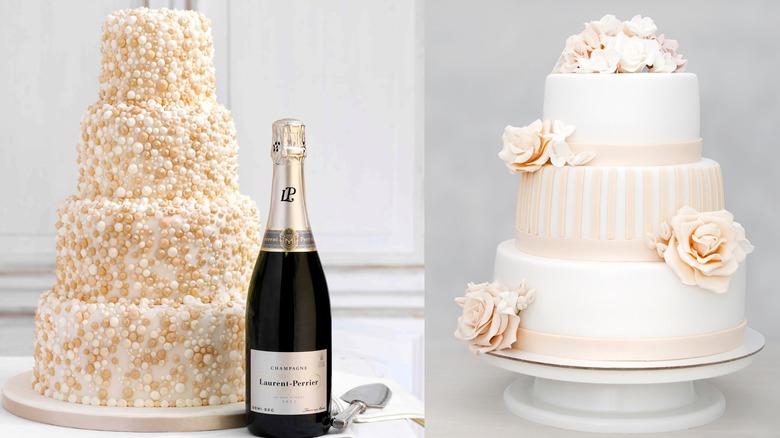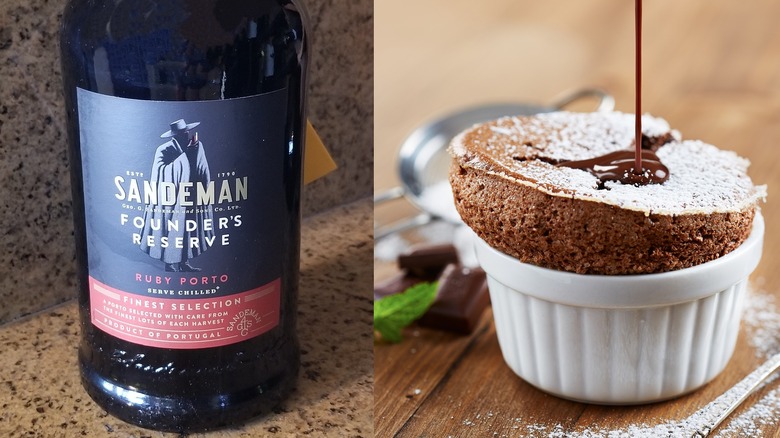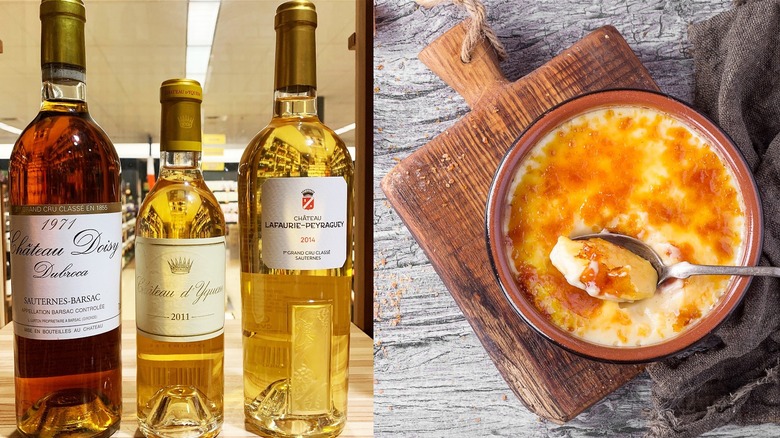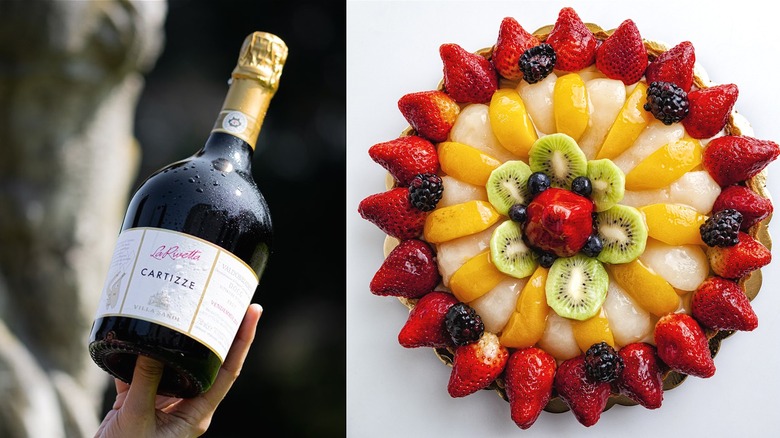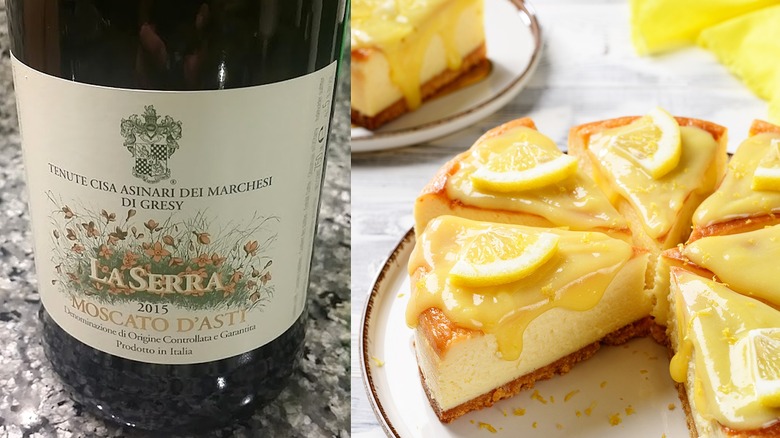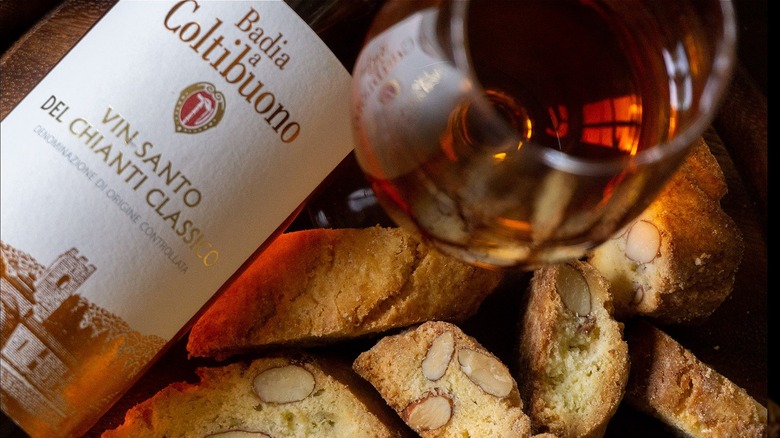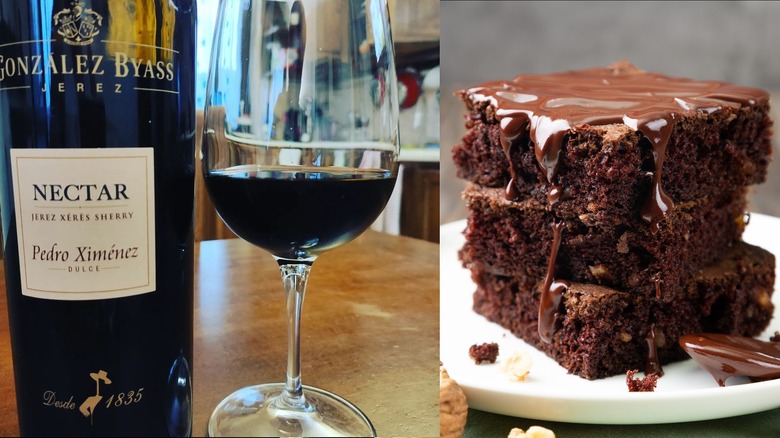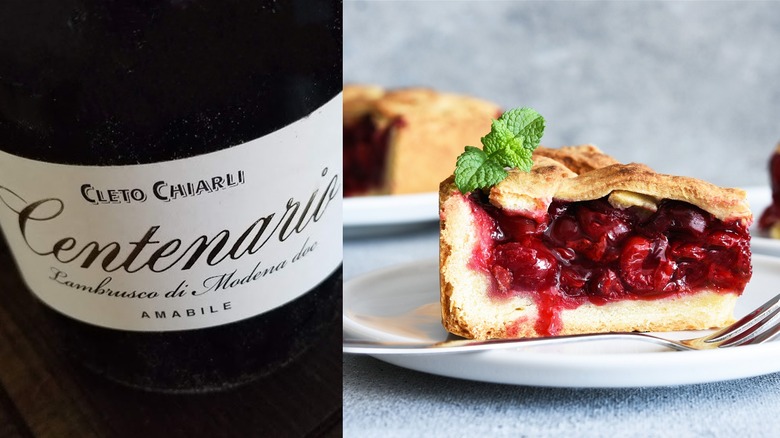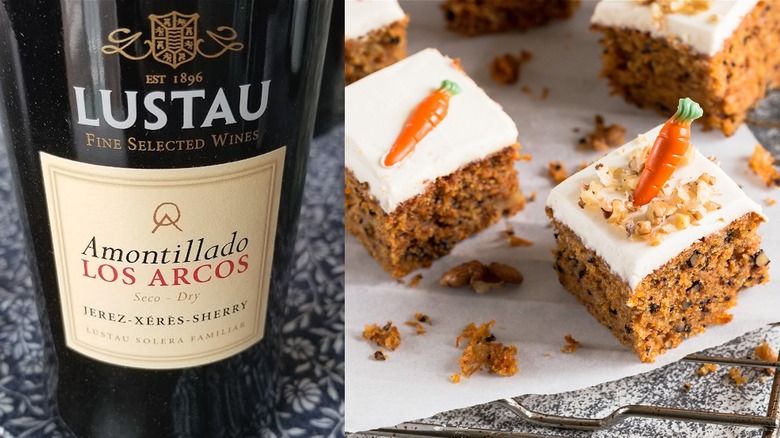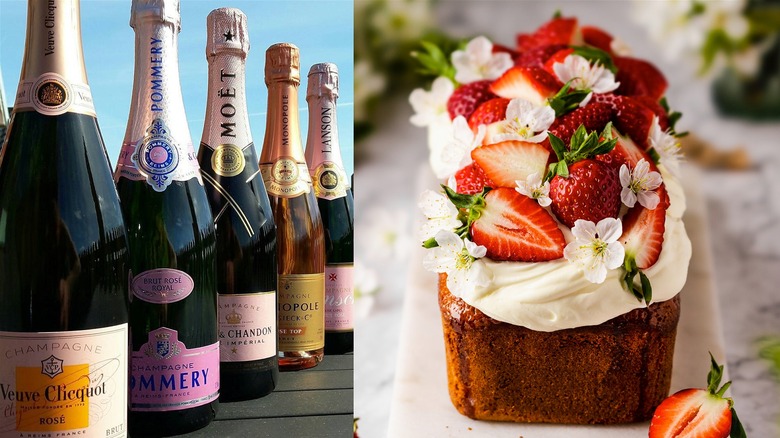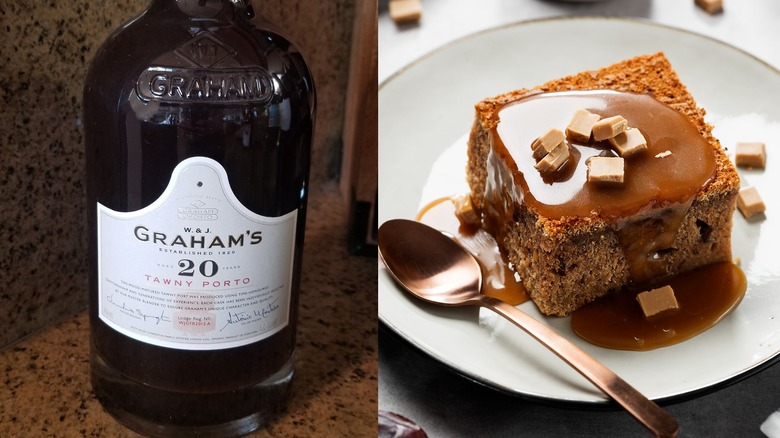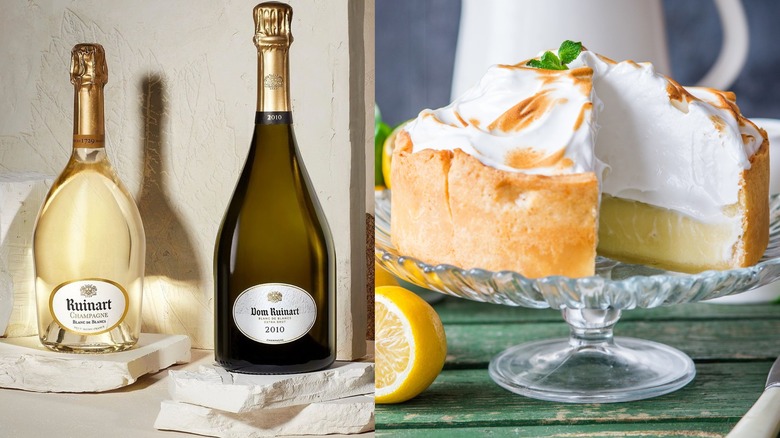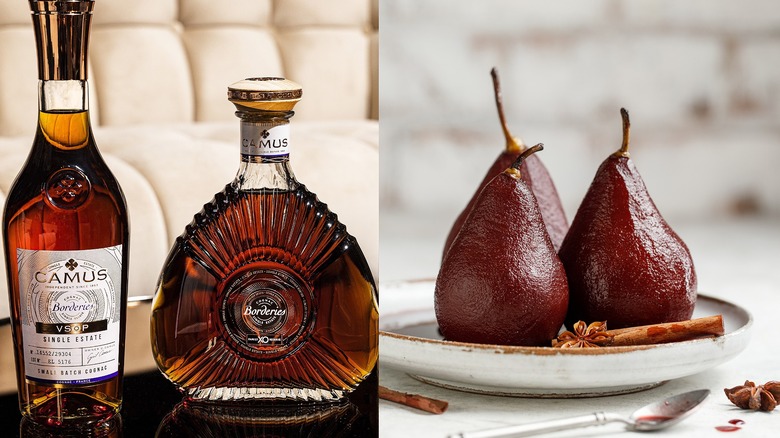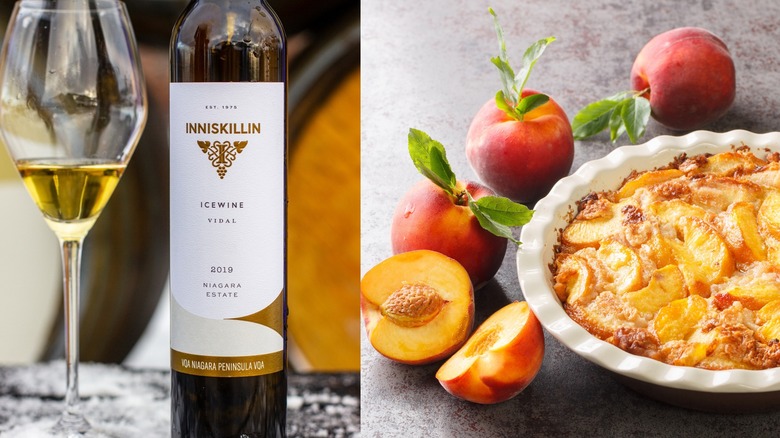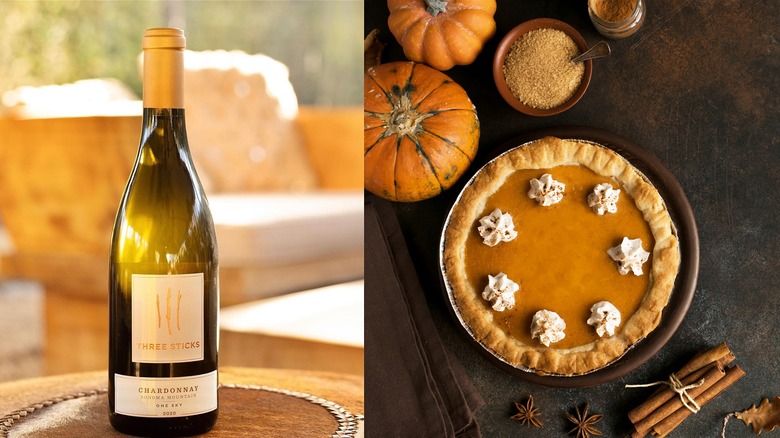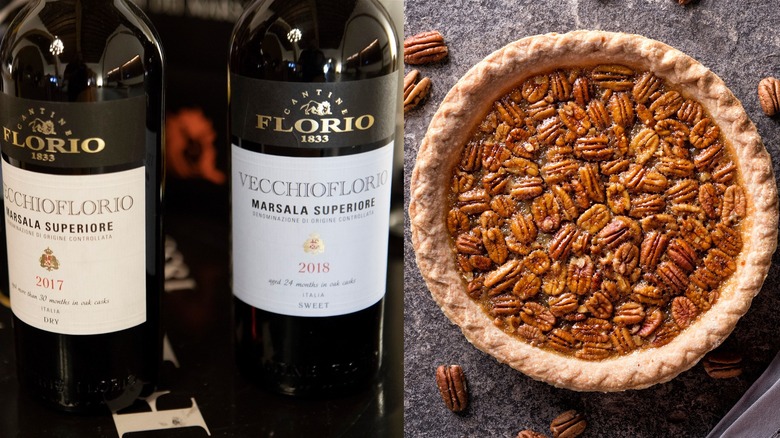The Classic Wine And Dessert Pairings You Need To Try, According To A Sommelier
A sugary treat to finish a meal is the perfect conclusion, satisfying the palate's desire for a sweet ending. The Thanksgiving feast is only complete with a slice of pumpkin pie. Likewise, no wedding reception takes place without a piece of cake to toast the happy couple. And nothing is more American than apple pie. Adding a wine pairing can further elevate the dessert experience. Wine is a natural flavor enhancer for all types of foods, from savory to sweet.
However, pairing wine with dessert can be tricky. The general pairing rules follow the same guidelines of any wine and food pairing, including that the flavors of the wine and dessert should complement each other. However, the wine must be sweeter than the dessert to ensure the combination does not taste flat or come across as bitter. The wine must also have texture and body to stand up to the dessert's weight while having acidity and freshness to balance the richness.
As a trained sommelier and long-time wine and spirits writer, I have spent years identifying the ideal pairings for a range of wines and foods, including the sweet ones. With this in mind, we have compiled a guide of delectable wine pairings for 18 classic desserts, from chocolatey and fruity options to traditional cakes to pies, allowing you to discover how adding a glass of wine to your favorite dessert will transform the flavor.
Brachetto d'Acqui with chocolate mousse
A bowl of decadent chocolate mousse will satisfy the cravings of any chocolate lover. It seems wild that the simple combination of chocolate and eggs, slowly cooked over low heat to thicken, is such an indulgently rich, satisfying treat. To enhance the chocolatey taste while adding fruity freshness to the palate, pair the dessert with a glass of Brachetto d'Acqui.
With layers of red rose petals, ripe red raspberry, and wild strawberry notes, the light, fruity, sweet Italian red wine melds with the creamy, chocolatey mousse, making a harmonious match. The low-alcohol Piedmontese wine's production style is typically slightly sparkling, frizzante, or fully sparkling, known as spumante. Either style will pair with the mousse as the bubbles will provide a refreshing, palate-cleansing respite from the intense richness of the dessert.
Quarts de Chaume with apple tart tatin
There is simply nothing sweeter than a glass of Quarts de Chaume with apple pie, apple cake, or an apple tart tatin. The orchard fruit-filled tart that bakes upside-down with a flaky pastry crust on top shines with the botrytized white wine from the Loire Valley of France. The wine is from within the Anjou region of the Loire Valley, where the chenin blanc grape variety thrives in the cool climate that allows the grapes to develop noble rot or Botrytis cinerea.
This gray fungus causes late-harvested fruit to shrivel, concentrating and intensifying the grape's sweetness, creating a dessert wine that, with age, creates baked apple, honey, and irresistible ripe peach flavors. Though Quarts de Chaume is one of the most famous French dessert wines, only 20 producers craft this delicate, luscious dessert wine with a hint of crushed-stone minerality from roughly 100 acres of vineyards.
Demi-Sec Champagne with wedding cake
We have all experienced the cutting of the cake at a wedding reception. A glass of Champagne often accompanies the cake for this time-honored tradition to toast the happy couple. Far too frequently, the Champagne is a dry, brut style. While the refreshing, balanced wine is an acceptable option for toasting at other times throughout the celebration, it is the worst option to pair with a traditional vanilla sponge wedding cake iced in sugary frosting. The cake is too sweet for the dry sparkling wine, causing both to taste off.
Instead, pair the cake with a semi-sweet, or demi-sec, sparkling wine, like Laurent-Perrier Demi Sec Champagne. While not as sweet as a doux, the sparkling style with the highest residual sugar, demi-sec, has between 32 and 50 grams of residual sugar, according to the Union des Maisons des Champagne. The non-vintage demi-sec has just the right sweetness to harmonize with the cake, providing fruity peach and apple, roasted hazelnut, and creamy honey flavors on the palate.
Ruby port with chocolate souffle
Port wine comes in a range of styles, from sweet, juicy, and fruit-forward to nutty, spicy, and rich with caramel and toffee flavors. The lighter-style ruby port makes an excellent pairing with a light, airy chocolate souffle. From steeply terraced vineyards in Portugal's Douro Valley, a ruby port is a fortified wine that uses a blend of grape varieties like tinta roriz, touriga nacional, and touriga franca that ages for a short period in wooden casks before bottling while still young to ensure the dessert wine has optimal fruitiness.
With flavors of wild berry, red cherry, Sandeman Founder's Reserve ruby port is fleshy, luscious, and inviting. The blend is a mix of five-year-aged port with an easy-drinking, approachable style that matches well with any chocolate dessert. The wine has 20% alcohol by volume, so indulging in a small glass with the souffle is plenty to please the sweet tooth.
Sauternes with crème brûlée
Creamy, custardy crème brûlée with a caramelized sugar top shines with the botrytized white Bordeaux wine known as Sauternes. Sauternes is not as light and delicate as its botrytized neighbor in the north, Quarts de Chaume, as Bordeaux is inherently warmer than Loire Valley, creating well-ripened flavors with a thick, sticky, syrupy consistency.
Late-harvest Sauternes uses predominantly sémillon fruit with sauvignon blanc exposed to cooling mist in the morning, causing the noble rot to thrive. Dry afternoon winds ensure the fungus does not destroy the fruit altogether. Exposing the grapes to this pattern of humid morning mist and dry afternoon winds over several weeks intensifies the fruit flavors while adding richness and complexity, layering honeyed apricot, candied ginger, and orange marmalade that some call liquid gold.
Extra dry prosecco with a fruit tart
The classic fruit tart is a dessert to enjoy all year, as the combination of fruit on top of a thick vanilla cream custard is endlessly interchangeable. One tart can layer fresh stone fruit like peaches, plums, and apricots, and another with ripe strawberries, cherries, and blackberries. The tart can showcase tropical fruits like kiwi, mango, and papaya or boast slices of orchard fruit like apples, pears, and persimmons.
A fresh, fruity, off-dry prosecco wine is perfect with each option. The slightly sweeter, extra-dry style prosecco, with 12-17 grams of residual sugar per liter, is a fruity, lively sparkling wine with bright acidity and freshness that will cut through the tart's richness. A Prosecco Superiore DOCG option from the Cartizze region within Conegliano Valdobbiadene offers an earthy, crushed stone mineral note from the influence of the region's rocky, steep, hillside vineyards, adding an additional layer of complexity to the inviting wine.
Moscato d'Asti with lemon cheesecake
A tangy lemon cheesecake provides both tart and creamy flavors coming from the high acidity of the citrus and the cheese's fattiness. The dessert needs a wine pairing that will complement the zesty acidic notes, refreshing the palate while still standing on its own, ensuring its rich flavors don't mask the wine's taste. A light, sweet, fruity moscato d'Asti will pair nicely with the cake.
The slightly sparkling, fragrant white wine from the Piedmont region of Italy opens with perfumed floral aromas of lemon blossom and peach blossom, followed by layers of fresh citrus, stone fruit, and green grapes. The moscato's flavors will enhance the cake's citrusy sweetness and fruity flavors. The wine's effervescence will help cut through the richness of the cheese, particularly if the cake's base includes tangy goat cheese and cream cheese. Low-alcohol moscato is typically bottled around 5.5% alcohol by volume, making it a delicious option to enjoy any time of day.
Vin santo with biscotti
One of Italy's most classic pairings is a glass of vin santo dessert wine with an Italian biscotti cookie. Toasting with the duo becomes the Italian tradition, "cantucci e vin santo," and the perfect way to end a hearty meal. Biscotti is a twice-baked almond cookie with a hard, crunchy texture. Serving the cookies with vin santo provides the liquid relief the dry biscotti needs, as Italians use the drink to dip the cookies.
Though vin santo is available throughout Italy, it is most common in Tuscany, where winemakers craft the concentrated, golden-hued dessert wine from trebbiano and malvasia fruit. With a full-bodied, mouth-coating texture, the sugary dessert wine has caramel, honey, dried apricot, and hazelnut flavors. While unctuous, a nice note of freshness balances the wine's richness.
Pedro Ximenez sherry with dark chocolate cake
Sherry wine can be a complicated wine category as the fortified wine's style ranges from bone dry options with saline, citrus, and olive flavors to nutty, oxidized, dry oloroso sherries to syrupy sweet wines with dried fruit and molasses using Pedro Ximenez fruit. The fortified Pedro Ximenez sherries, like Nectar from Gonzalez Byass, from southern Spain, have intense, syrupy flavors and texture from the process of laying harvested grapes on mats to dry in the sun, known as asoleo, causing the fruit to raisin, evaporating the water and concentrating the sweet flavors, revealing dried fig, prune, toffee, and chocolate, delicious with a rich, dark chocolate layer cake. The cake has sweetness and bitterness, which plays off the drink's sugary notes, adding interest and balancing the overall flavor.
Lambrusco with cherry pie
The 4th of July picnic is only complete with a fireworks finale topped off with a slice of cherry pie. With a syrupy cherry filling, the summertime treat tends to be overly sweet, especially if using the filling from the can. To balance the flavor, opt for an amible (off-dry) or dolce (sweet) style of lambrusco. The sparkling red wine from the Emilia-Romagna region of Italy is juicy, fresh, and light.
There are various types of lambrusco grape varieties. To pair with sweet desserts, we recommend a lambrusco grasparossa di castelvetro or a lambrusco salamino di santa croce, crafted into an off-dry or sweet style, like Cleto Chiarli Centenario Grasparossa di Castelvetro Amible. The sparkling wine balances the pie's sweetness with an inky purple color, aromas of violets, wild berries, red cherries, and a refreshing effervescence.
Amontillado sherry with carrot cake
A dry-style sherry, like an amontillado from Lustau, can also pair with desserts if the dish's sweetness shows restraint, like an earthy carrot cake. The sherry's production begins by aging the fortified wine under a layer of yeast in a barrel known as flor, lending a note of freshly baked bread to the sherry. It then transitions to an oxidized sherry, exposing the aging wine to oxygen in the barrel and giving the sherry a well-rounded texture.
The aging technique lends tertiary notes of dried fruits that meld with hazelnut and toasted warm spice characteristics of nutmeg and allspice from the minimum eight-year barrel aging in the solera. The carrot cake has similar nutty, spicy, earthy characteristics, with sweetness from the raisins and carrots without appearing overly sugary. Combining the duo creates a harmonious balance.
Brut rosé Champagne with strawberry shortcake
Strawberry shortcake is one of those desserts that you can indulge in without feeling overly guilty. The dish begins with a light, fluffy cake, traditionally more like a biscuit than a cake, topped with fresh berries and whipped cream. While you can add sugar to each ingredient, it is unnecessary as the fruit and fresh cream have a natural sweetness that will satisfy any appetite for dessert.
We suggest trying a brut-style rosé Champagne, like Pommery Brut Rosé Royal, to pair with the dish. Pommery's salmon pink colored, traditional method sparkling wine ages for three years in the bottle. The aging creates layers of yeasty biscuit dough and sweet cream that mix with the wine's natural red berry, red apple, and cherry flavors, providing a delicious complement to the strawberry shortcake.
Tawny port wine with sticky toffee pudding
One of Britain's most traditional desserts is sticky toffee pudding. The decadent dessert is a classic end to many holiday meals. The pudding's base is a date-soaked cake that is topped with a thick, rich, caramel toffee sauce that many, including the future Queen of England, Duchess Kate, find irresistible. The dessert is excessively sweet and will benefit from a pairing that will tame the sugary flavors.
We suggest an aged tawny port wine, like Graham's 20-year-old Tawny. The unctuous 20-year-barrel-aged port wine has layers of dried fig and dried orange peel, sweet baking spice, and toasted toffee flavors thanks to the extensive time in contact with the oak barrel while aging, enhancing and melding with the pudding's rich flavors.
Blanc de Blancs Champagne with lemon meringue pie
A zesty, citrusy lemon pie with a thick meringue top is perfect with a glass of Blanc de Blancs Brut Champagne. While the wine is considered dry, the governing body of Champagne, the Union des Maisons des Champagne, defines the Brut style as containing some residual sugar, up to 12 grams per liter, enhancing the wine's orchard, citrus, and melon notes. The 100% Chardonnay Blanc de Blancs wine's fruity citrus and orchard fruit flavors will enhance the lemon meringue pie's fresh fruity citrus flavors.
Crafting the wine occurs in the traditional method, or méthode champenoise in French, where the second fermentation occurs in the bottle to create the bubbles. During the process, the wine rests on the lees, or yeast, for an extended period. Aging this way lends yeasty, brioche notes to the wine, matching the pie crust's flavors and a marzipan note highlighting the toasty, fluffy egg-white meringue.
Cognac with poached pears
Red wine-poached pears are one of the most elegant desserts to enjoy, with a naturally fruity sweetness from the pears and wine that isn't overpoweringly sugary and a touch of spice from the inclusion of cinnamon sticks or star anise in the poaching liquid. As there is restraint in the dessert's sweetness, the pears are a heavenly match with an aged cognac, highlighting the dish's fruit and spice notes.
With a younger cognac, like a VS, or "Very Special," the eaux-de-vie ages for a minimum of two years in French oak barrels, revealing the fruity apple, pear, and peach flavors from brandy's base wine of ugni blanc grapes with subtle spice notes, that will meld nicely with the dessert. However, selecting an XO, or "Extra Old" cognac, where the youngest brandy in the blend ages for a minimum of 10 years in a barrel, will have more caramel, roasted nut, dried fruit, and spice notes, which will elevate the dessert's complexity.
Ice wine with peach cobbler
Nothing says summer like a classic peach cobbler made with ripe, juicy peaches straight off the tree. The pairing for the fruity dessert with its syrupy filling needs complementary flavors, allowing the seasonal favorite to shine. Opting for an ice wine will provide the necessary fruity sweetness the cobbler needs.
To produce the wine, grapes are left on the vine long after the average harvest time, well into the winter months, when icy cold temperatures freeze the grapes on the vine. The process can take several months to complete as vintners allow the fruit to freeze and thaw several times, concentrating the fruit's juices and becoming incredibly sweet.
Some of the finest expressions come from Canada using the white wine grape, vidal. The thick-skinned, high-acid variety has stone fruit flavors of peaches and apricots, delicious with the cobbler with enough natural freshness to keep the palate light and balanced.
Chardonnay with pumpkin pie
The only non-dessert, non-sparkling wine in the mix is a still chardonnay wine pairing with pumpkin pie. The dry white wine will pair nicely as pumpkin pie filling has a natural earthiness that isn't too sweet. The best option is an oak-aged version of the variety that undergoes malolactic fermentation, like Three Sticks Winery Sonoma Mountain One Sky Chardonnay, with warm spice, vanilla, and orchard fruit notes enhancing the pie's clove, nutmeg, and cinnamon spice flavors.
The well-rounded wine also has bright acidity from the high elevation and the Pacific Ocean's influence, lifting the palate and providing freshness. Creamy brioche notes derived from the fermentation method and barrel aging ensure the wine enriches the buttery, flaky pie crust, creating a harmonious bite of pumpkin pie and chardonnay.
Marsala with pecan pie
An earthy, sweet, nutty pecan pie is one of the most classic pies to enjoy around the holiday season. With a flaky golden brown crust, sweet caramel filling, and toasted nut top, the dessert delivers a multitude of textures and flavors. As you would discern from the name, the dominant taste comes from the pecans, so bringing in a wine with similar nutty notes as the pairing will further enhance that flavor.
We suggest a sweet marsala wine from Sicily, like Vecchioflorio Sweet Marsala Superiore. The wine ages for at least two years in oak casks, imparting sweet spice, vanilla, and nutty notes into the late-ripening fruit's raisin, dried fig, and caramel notes, perfect with the pecan pie pairing. As the duo has ample sweetness, we suggest a simple, unsweetened whipped cream topping, allowing the wine's natural flavors to shine.
Our Methodology
The basis for our pairings began by considering classic desserts that are common throughout the country. With our list, we considered trusted reviews from within the wine industry, personal expertise, and taste tests of dry and sweet wines to pair with each dessert. As a Certified Sommelier and Specialist of Wine with 20 years of experience writing about wine and wine and food pairings, I leaned into my knowledge of the subject to create the tastiest combinations for classic dessert offerings.
Static Media owns Tasting Table and The Daily Meal.
